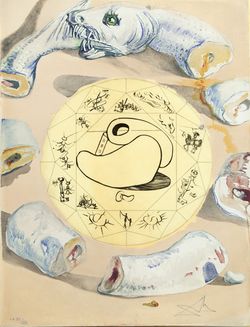Difference between revisions of "Template:Oroboros picture of the month"
From Bioblast
Beno Marija (talk | contribs) |
Beno Marija (talk | contribs) |
||
| Line 5: | Line 5: | ||
:''' Dalí's Ouroboros. ''' | :''' Dalí's Ouroboros. ''' | ||
: "Dalí's Ouroboros is more naturalistic than his other prints in Alchimie des Philosophes, and its features are similar to an eel or sea serpent. It is cut in many pieces, though the head biting the tail remains one piece. The Ouroboros maintains its circular shape, though the oozing pieces of the serpent interrupt its sense of eternity. The decaying pieces also represent the alchemical stage of putrefaction, when the alchemical matter decomposes. The pieces are arranged around a large, circular gem. Each facet of the jewel contains a different symbol, including keys and ants. Dalí frequently used ants as symbols of decay and temporality. In this sense, the ants are fitting in their placements around the dead Ouroboros, a symbol of eternity now subjected to the effects of time. The center features an interlocking Yin and Yang. However, the shapes seem intentionally ambiguous, and also resemble slabs of meat similar to the pieces of the serpent." (Source: [ | : "Dalí's Ouroboros is more naturalistic than his other prints in Alchimie des Philosophes, and its features are similar to an eel or sea serpent. It is cut in many pieces, though the head biting the tail remains one piece. The Ouroboros maintains its circular shape, though the oozing pieces of the serpent interrupt its sense of eternity. The decaying pieces also represent the alchemical stage of putrefaction, when the alchemical matter decomposes. The pieces are arranged around a large, circular gem. Each facet of the jewel contains a different symbol, including keys and ants. Dalí frequently used ants as symbols of decay and temporality. In this sense, the ants are fitting in their placements around the dead Ouroboros, a symbol of eternity now subjected to the effects of time. The center features an interlocking Yin and Yang. However, the shapes seem intentionally ambiguous, and also resemble slabs of meat similar to the pieces of the serpent." (Source: [https://libmedia.willamette.edu/hfma/omeka/exhibits/show/salvador-dali--alchimie-des-ph/the-ouroboros libmedia.willamette.edu] | ||
<br> | <br> | ||
<br> | <br> | ||
Revision as of 08:42, 7 September 2021
|
